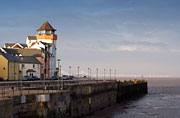 Portishead is a coastal town in North Somerset, only 12 miles from Bristol. It has never really been popular as a tourist resort mainly because it does not have particularly attractive beaches. There are good views from here across the Bristol Channel to Wales.
Portishead is a coastal town in North Somerset, only 12 miles from Bristol. It has never really been popular as a tourist resort mainly because it does not have particularly attractive beaches. There are good views from here across the Bristol Channel to Wales.
Evidence of early settlements has been provided by finds of Stone Age axes and other tools. It is known that a town existed in Roman times and the name is fairly self-explanatory, meaning the port at the head of the river. The town was built at the mouth of a small tributary of the River Avon and the main street once ran down to the water. Iron mooring rings can still be seen on the stone walls of the street, showing where fishing boats once moored. The Domesday Book records that Portishead was worth 70 shillings, which must have been quite a large sum in the 11th century.
In the mid 19th century, at the height of the iron and steel era, both a pier and a deep water dock were built to accommodate large ships that found difficulty entering Bristol Harbour. They brought cargoes from all over the world, taking local products in return. One of the major exports was coal. Much of the building in Portishead took place around this time and most of the houses and other structures are from the Victorian era.
In 1926 and then in 1949, two coal fuelled power stations were built adjacent to the docks. The first of these began generating electricity in 1929. Both power stations used coal produced in the local Somerset coalfield. The coal was delivered by train along the Portishead branch of the Great Western Railway, which had originally opened in 1867 as the Bristol and Portishead Pier and Railway Company.
At one time, Portishead had two passenger stations on the GWR branch line, one near to the town centre of Portishead and the other at the pier. At one time there was also a light railway line between Clevedon and Portishead; this closed in 1940.
Until the early 1980s, there were many industrial activities in Portishead docklands. At one time, these included a thriving chemical factory. This activity ceased with the closure and demolition of the power stations.
This demolition site has been redeveloped to provide a range of housing, and an imitation fishing village, complete with cottages and a barbican tower. Recently, the harbour area has also been revamped to include a marina for all kinds of pleasure craft. Further areas to the east of the harbour, towards Portbury, are also in the process of redevelopment and Portishead is becoming an increasingly attractive town to tourists.
The local coastline is of environmental and geological interest, but is stony and muddy rather than sandy. The town’s main park is the attractive Lake Grounds, built in the early 20th century around an artificial lake. One of few surviving outdoor swimming pools is situated on the shore next to this park and is open during the summer months. Above the Lake Grounds is Battery Point, where guns were once placed to guard the Severn Estuary.
Another claim to fame is that the Bristol trip-hop group, Portishead, is named after the town. This is even though the group members claim to hate the place!




